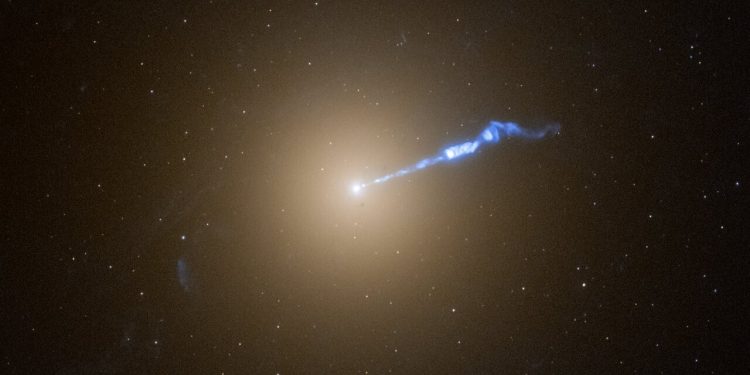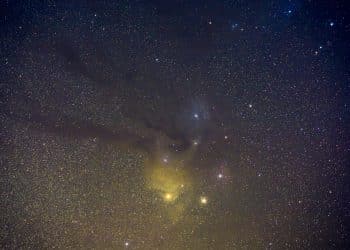Astronomers using NASA’s Hubble Space Telescope have stumbled upon an unexpected cosmic interaction in the galaxy M87. A powerful jet emanating from a supermassive black hole appears to be responsible for igniting a higher frequency of stellar eruptions, known as novae, in its surrounding region. This surprising find adds a new dimension to our understanding of how black hole jets can influence nearby star systems, offering a fresh perspective on the chaotic environments within galaxies.
An Unexpected Cosmic Chain Reaction
In the heart of the M87 galaxy, a supermassive black hole—boasting a mass 6.5 billion times greater than our Sun—emits an immensely energetic jet that stretches for thousands of light-years. While anything directly in the path of this jet would be obliterated, astronomers have now found that even regions just outside its trajectory are not immune to its disruptive forces.
Hubble’s observations revealed that star systems in the vicinity of the jet experience an unusual uptick in stellar explosions, known as novae. Novae occur in binary systems, where a white dwarf star siphons material from a companion star. When enough hydrogen accumulates on the white dwarf’s surface, it triggers a thermonuclear explosion. However, what makes this discovery so remarkable is that these binary systems, located near the black hole’s jet, erupt with far greater frequency than their counterparts elsewhere in the galaxy.
New Theories on Black Hole Jet Interaction
The discovery has left scientists searching for an explanation. One leading hypothesis is that the jet’s immense energy somehow accelerates the process by which hydrogen is transferred between stars in these binary systems. The jet might be pushing material into the white dwarf’s orbit more rapidly, causing it to “refuel” faster and ignite more frequent eruptions. Another theory suggests that the radiation from the jet could be exerting pressure on nearby stars, speeding up the transfer of hydrogen between them.
Yet, the exact mechanism remains elusive. Lead researcher Alec Lessing of Stanford University explained, “This phenomenon challenges our current understanding of how black hole jets interact with their environments. We are witnessing something we have not accounted for in our models.” This finding suggests that black hole jets may have more far-reaching effects than previously thought, impacting star formation and activity in ways we are only beginning to understand.
Hubble’s Unique Contribution
Hubble’s capability to observe such distant phenomena was key to this groundbreaking discovery. Over the course of nine months, the space telescope captured detailed images of the M87 galaxy, allowing researchers to pinpoint 94 separate nova events. Surprisingly, nearly half of these events were concentrated near the black hole’s jet, reinforcing the theory that the jet is playing a significant role in triggering these stellar eruptions.
In previous studies, evidence hinted at increased stellar activity near the M87 jet, but the precision of Hubble’s observations provided the first concrete statistical proof. Michael Shara, a co-researcher from the American Museum of Natural History, expressed his amazement: “Hubble’s observations gave us the clarity we needed. Once we mapped the nova explosions across the galaxy, the pattern near the jet was unmistakable.”
Black Holes and Stellar Evolution
This revelation not only sheds light on the workings of M87’s black hole but also opens up new avenues for research into the broader role black holes play in shaping the galaxies around them. Supermassive black holes, once thought to primarily influence matter only in their immediate surroundings, may actually exert influence on much larger areas of the galaxy.
Chiara Circosta, an ESA research fellow, emphasized the broader implications of the discovery. “These observations provide a rare opportunity to understand how the intense environment around a supermassive black hole can shape the destiny of nearby stars. It raises new questions about the evolution of galaxies and how black holes might trigger star formation—or, in this case, accelerate the life cycle of stars through eruptions.”
What Comes Next?
As technology advances, the potential to study these interactions more closely will only improve. With Hubble continuing to provide unprecedented views of distant galaxies, and the James Webb Space Telescope, researchers hope to uncover even more about how black holes influence their surroundings. The findings in M87 offer a tantalizing glimpse into the powerful, unseen forces that govern our universe and raise new questions about how common these interactions might be across other galaxies. For now, though, this discovery stands as a testament to the profound role black holes play in the complex web of cosmic evolution.











